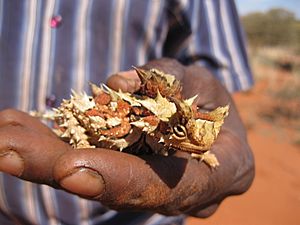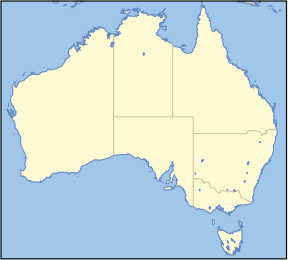Angas Downs Indigenous Protected Area facts for kids
Quick facts for kids Angas DownsIndigenous Protected Area |
|
|---|---|
|
IUCN Category VI (Managed Resource Protected Area)
|
|
| Nearest town/city | Imaṉpa |
| Coordinates | 25°02′S 132°16′E / 25.033°S 132.267°E |
| Area | 320,500 ha (3,205 km2) |
| Established | 10 June 2009 |
| Managing authorities | Lisanote Pty Ltd |
The Angas Downs Indigenous Protected Area is a special protected area in the south of the Northern Territory, Australia. It's a huge piece of land, about 320,500 hectares (which is 3,205 square kilometers!). This land is called a pastoral lease, meaning it's rented from the government mainly for raising animals.
What makes Angas Downs special is that it's owned by the Indigenous community of Imaṉpa. It's located along the Luritja Highway, not too far from famous places like Uluṟu-Kata Tjuṯa National Park and Kings Canyon.
Angas Downs became an Indigenous Protected Area on June 10, 2009. This means it's now part of Australia's National Reserve System, which helps protect important natural and cultural places.
This area is the traditional homeland for the southern Luritja and northern Yankunytjatjara people. They are known as Matutjara and speak a mix of both languages. The people living in Imaṉpa today include Luritja, Yankunytjatjara, and Pitjantjatjara people.
The land has many important places, including songlines and sacred sites, which are very special to these families and their Tjukurpa (their traditional laws and stories). Many animals here are also seen as ancestral totems. These totems remind people about their identity, family connections (called kinship), and their ancestors. For thousands of years, the plants and animals on this land have also been important sources of food for the local people.
Sadly, in the past, some ways the land was managed caused damage. Many native animals disappeared, and important food sources like game animals and edible plants became harder to find. Now, feral animals like camels and horses, and unwanted weeds, are big problems. To help, the Central Land Council runs a ranger program in Imanpa to look after the land.
Contents
History of Angas Downs
Early Days and Traditional Owners
The Angas Downs area has always been the traditional home of the southern Luritja and northern Yankunytjatjara people. They are known as Matutjara and speak a special mix of their two languages.
The Liddle Family's Arrival
In the early 1920s, a pioneer named William Liddle came to this area. He was looking for land to raise sheep. He found water at a place called Wollunga, which is a natural waterhole. He also found other water sources further south.
In 1927, William Liddle bought 2,000 sheep and brought them north. In 1930, he received a pastoral lease from the government for the land around the Wollara Range. He named his new property Angas Downs. William settled there with his wife, Mary, who was an Aranda woman, and their children. They built their first home in a pass in the Wollara Range, which became known as the Liddle Hills.
Changes and Growth
In 1945, William sold Angas Downs to two of his sons, Arthur and Milton. They moved the main house to a new spot where there was a more reliable water source. They also changed from raising sheep to raising cattle. A few years later, in 1947, another of William's sons, Harold Liddle, started his own cattle station nearby at Mount Ebenezer. Arthur Liddle took over Milton's share of Angas Downs in 1956.
Documenting Aboriginal Culture
From July to October 1962, a researcher named Frederick G. G. Rose stayed at Angas Downs. He was very interested in learning about the local Aboriginal people and their way of life. He also studied how their culture was changing because of contact with White civilisation. He wrote down the family histories (called genealogy) of the Liddle family and other Aboriginal families living on Angas Downs.
Return to Indigenous Ownership
The Aboriginal community of Imaṉpa was formed near Mount Ebenezer in 1978. Arthur Liddle and his family continued to raise cattle at Angas Downs through the 1980s and 1990s. Like many farms at that time, Angas Downs faced financial challenges.
Finally, on May 2, 1994, the nearby Imaṉpa community bought the property. Since then, it has been owned by the Imanpa Development Association and managed by their company, Lisanote Pty. Ltd. In 2009, Angas Downs was officially declared an Indigenous Protected Area. The property still has about 300 to 400 cattle, but they are kept in a specific area to protect the rest of the land.
Layout of the Area

The Angas Downs reserve covers about 3,205 square kilometers. Most of the land is flat, but there are two main mountain ranges. These are the Kernot Range in the southwest and the Wollara Range (also called Liddle Hills) in the middle.
The old homestead (the original house) is located in the middle of the property, in a valley of the Wollara Range. The new homestead is further south, along the Luritja Highway. This highway runs north to south through the middle of the property and connects with the Lasseter Highway at the southern end of the reserve.
Important natural waterholes (called soakages) on the property include Wollunga and Yaua in the north, Wallara in the southeast, and Wilpiya (also spelled Wilpia or Wilbia) near the Kernot Range.
Amazing Biodiversity

Angas Downs is home to many different types of plants and natural environments. You can find mulga woodlands, sandy areas, limestone plains, spinifex grasslands, sand dunes, and desert oak woodlands. There are also floodplains and quartzite hills.
Many native mammals live here, including echidnas, the Ooldea dunnart, kultarr, red kangaroo, eastern wallaroo, Gould's wattled bat, lesser long-eared bat, spinifex hopping mouse, sandy inland mouse, and dingos. Sadly, Mala (a type of wallaby) used to live here but are no longer seen.
More than 90 different kinds of birds have been seen in the reserve. Emus, bustards (also known as bush turkeys), and bush stone-curlews are some of them. You can also commonly spot mulga parrots, Major Mitchell's cockatoos, Australian ringnecks, Bourke's parrots, and budgerigars.
Since 2009, over 50 different reptile species have been found in this protected area. These include various snakes like Simoselaps betholdi (Jan's banded snake) and Suta punctata (little spotted snake). There are also lizards like the Tiliqua multifasciata (centralian blue tongue) and different types of geckos and skinks.
Images for kids
-
Quandong (Santalum acuminatum) fruit & seeds at Angas Downs, NT
-
Burton's legless lizard on Angas Downs IPA, NT
-
Bynoe's gecko on Angas Downs IPA, NT
-
Remote camera capture of woma python on Angas Downs IPA, NT
-
Using Remote camera and lure to capture sand goanna on camera - on Angas Downs IPA, NT
-
Emu in captivity on Angas Downs


























